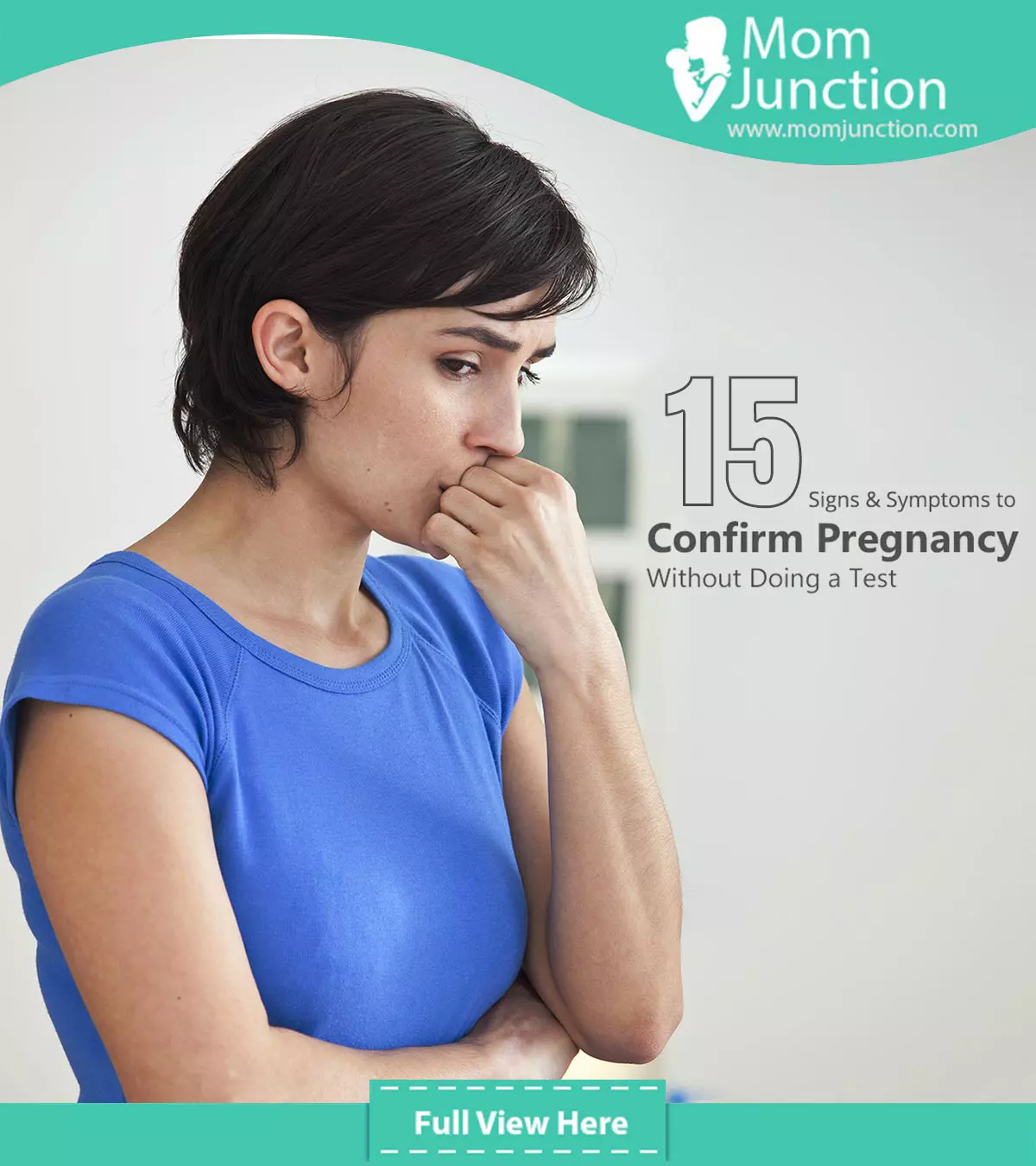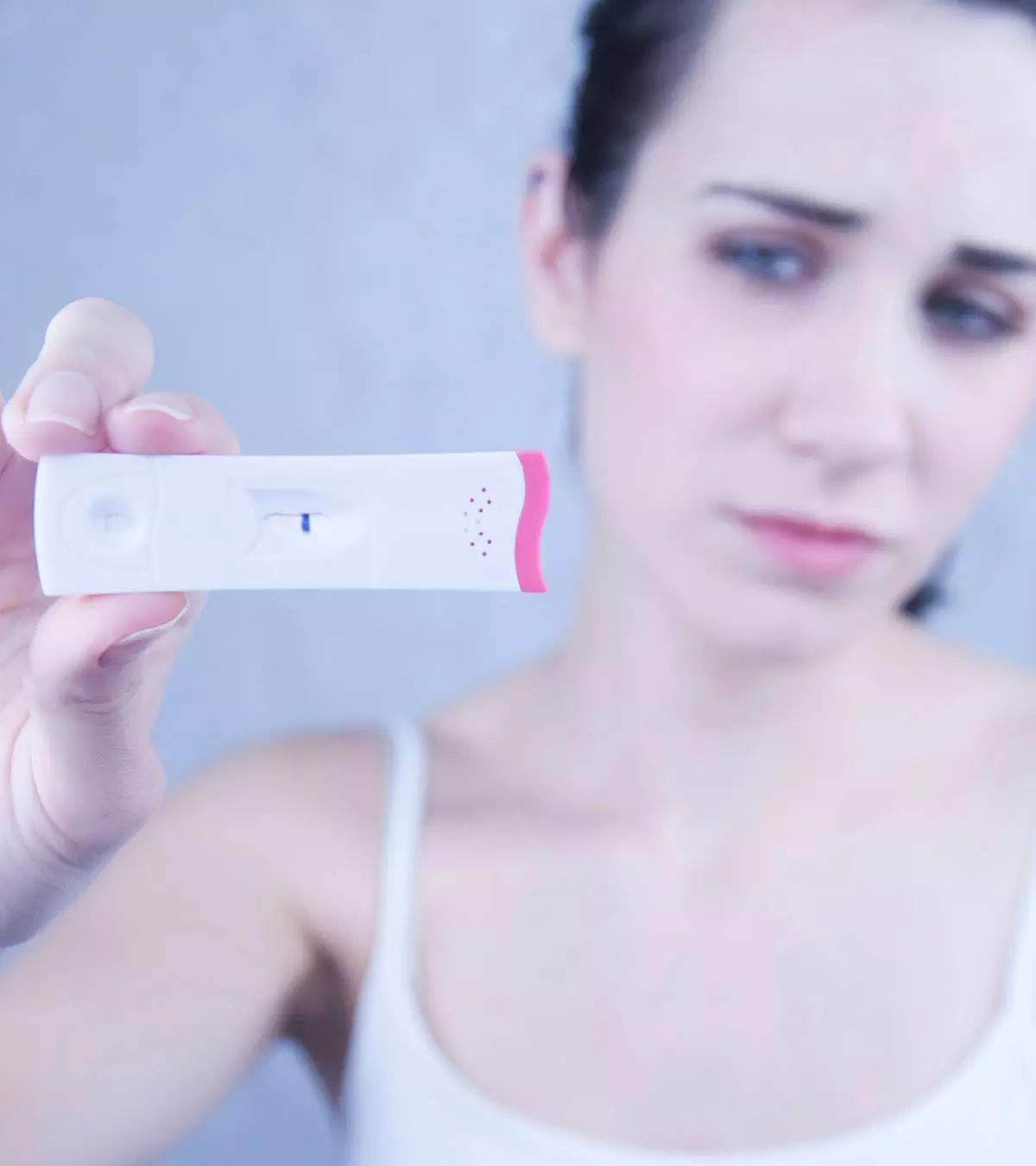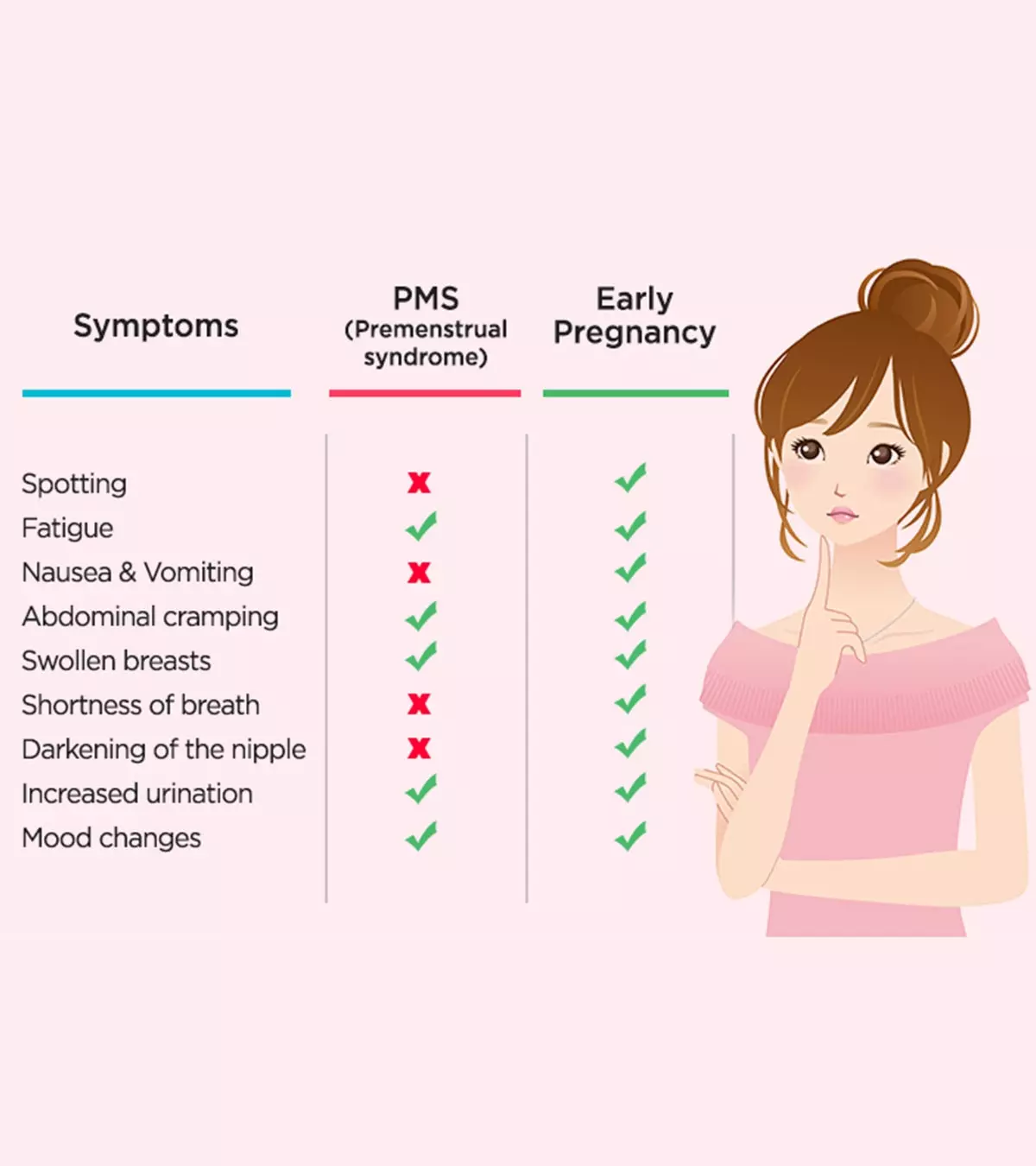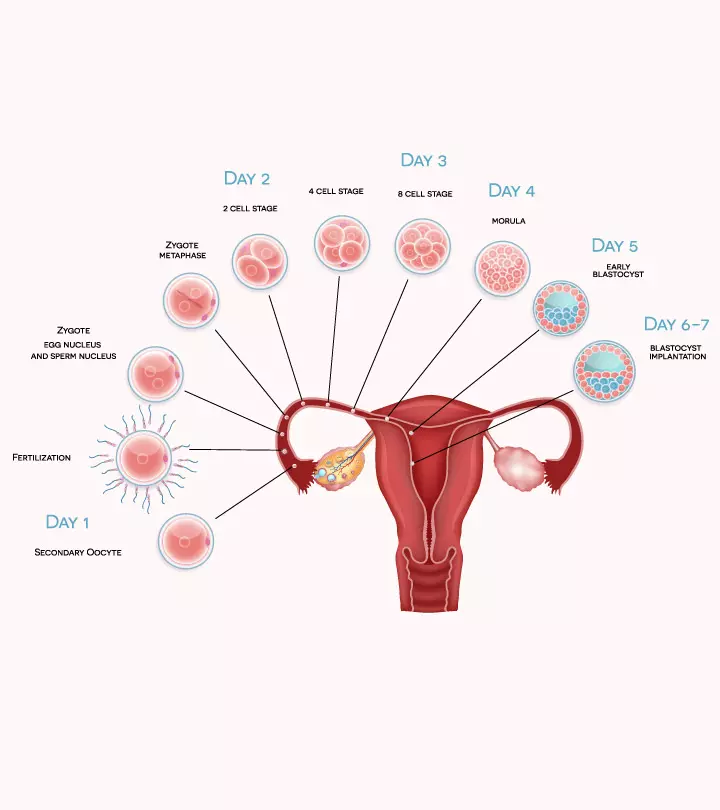
Image: ShutterStock

When does pregnancy implantation occur? Implantation is a physiological process in which the embryo attaches to the uterus for development. It is the earliest event of pregnancy that usually happens between six to 12 days after ovulation. However, the implantation days may vary slightly depending on when the fertilizationiThe process in which sperm meets and combines with an egg occurred after the ovulation, such as in the early fertility window or later.
Some women may experience symptoms such as cramps and bleeding during implantation. However, these may go unnoticed in a few cases. Understanding when implantation happens and its signs are important for those trying to conceive, as it marks the beginning of pregnancy. It can help distinguish between normal menstrual symptoms and early signs of pregnancy. Read on to know the signs and symptoms of implantation and when it usually occurs.
Key Pointers
- The fertilized egg attaches to the uterine wall, a process called implantation, within six to 12 days after ovulation.
- Implantation bleeding, which is often confused with a regular menstrual period, can occur in approximately 15 to 25% of women.
- Other indicators of implantation include cramping, breast tenderness, elevated basal body temperature, and increased urinary frequency.
- The embryo’s implantation process occurs in three phases.
- Abnormal implantation can result in pregnancy loss due to conditions such as ectopic pregnancy, hydatidiform mole, or placental issues.
What Is Implantation?
Implantation (of the human embryo) is the attachment of the fertilized egg (the blastocystiEarly stage of mammalian embryo development ) to the lining of the uterus. The American College of Obstetricians and Gynecologists (ACOG) defines the start of pregnancy as the point when the embryo implants into the uterine wall (1). It is an entirely natural process and an early stage of pregnancy that happens a week after ovulation (2).
Around 15 to 25% of women experience implantation bleeding, but is usually mistaken for menstruation as it happens at the same time of your cycle (3).
When Does Implantation Occur?
The implantation timeline or implantation window refers to the sequence of events leading up to the embryo’s successful attachment to the uterine wall. During implantation, the trophoblastiThe outer layer of a blastocyst that develops into the placenta cells of the embryo invade the uterine lining and establish a connection with the maternal blood supply (4).
The role of hormones in implantation. Hormones play a critical role in implantation. The hormone estrogen prepares the lining of the uterus for implantation, while the hormone progesterone helps to maintain the pregnancy after implantation (5).
The process of implantation is regulated by hormones such as leutinizing hormone and follicle-stimulating hormone, which help prepare the uterine lining for implantation (6). In most cases, implantation takes place around nine days after ovulation, but sometimes it may occur as early as seven days or as late as 12 days. So, if ovulation takes place on the 14th day after a period (average 28-day cycle), implantation might occur on the 23rd day.
Dr. Emily Osman, a board-certified obstetrician-gynecologist, reproductive endocrinologist, and infertility specialist from New Jersey, says, “Implantation occurs during a period called the window of receptivity, which is the time that the uterus is most receptive to an embryo. However, this time will vary according to the length of the cycle.”
During ovulation, the ovaries release the eggs. When the sperm enters the fallopian tubeiPair of tubes that carry eggs from ovaries to the uterus in women , it fertilizes the egg within 12 to 24 hours of ovulation. The fertilized egg, known as a zygoteiA cell formed after the union of an egg and a sperm during fertilization , then travels down the fallopian tube. During this time, the zygote multiplies several times to form a blastocyst, which enters the uterine cavity in five to six days after fertilization.
It then implants to the uterus in a day or two. Therefore, the whole process from fertilization to implantation takes six to ten days. This means that implantation occurs between the 20th and 24th days of your regular menstrual cycle (7).
 Did you know?
Did you know?Possible Signs And Symptoms Of Pregnancy Implantation
Every pregnancy is different, and so are the implantation symptoms. They may also differ from the first pregnancy to the subsequent ones. Some women do not notice any implantation symptoms, so consulting a healthcare provider is advised for professional guidance and personalized care. Listed below are the possible implantation signs.
1. Implantation bleeding or spotting

Image: Shutterstock
It is one of the primary symptoms of implantation and happens when the embryo embeds into the uterine wall (8). Implantation bleeding may be pinkish, scanty, and not as red and heavy as the period bleeding. It is not consistent and does not form clots. The bleeding may be on and off and last from a few hours to two days.
Carmen Fourie, a blogger who likes to live in sync with her fertility cycle, says, “During my first pregnancy, which was a chemical pregnancyiAn early miscarriage, often occurring shortly after implantation , on the ninth day post-ovulation, I had the tiniest amount of spotting, that I am assuming was from implantation, because I don’t generally spot two weeks before my period, at all (i).”
2. Implantation cramping
The second common symptom after spotting is implantation cramping, which is similar to period cramping (9). However, these cramps are milder and are less painful, and may last for a couple of days. You may experience them in your back and lower abdomen. Implantation pains are sometimes associated with continuous contractions in the uterine wall. If the cramping is severe and longer, making it unbearable, it is advisable to see your doctor.
Recounting her experience with implantation symptoms during her third pregnancy, Marion, a vlogger and mother of three, shares, “About a week and a half before my period was due, I remember feeling strong cramps—probably like the first day of my period. But I knew my period wasn’t due, and I didn’t feel like my period. I just felt the cramping, and it came on suddenly. Within half an hour, I started to notice a lot of cramping, and it lasted for a few hours, probably through the morning and into the afternoon and evening. I felt really tired and just off, with some classic pregnancy symptoms like nausea, not feeling hungry, and being drained. I definitely felt something. Of course, there’s no 100% proof of what it was, but based on the timing and how I felt, I believe it was implantation cramping (ii).”
3. Breast changes

Image: IStock
Soon after implantation, your body begins to change. Breasts undergo changes such as tenderness, soreness, and swelling. It is due to the changing female hormone levels after conception (10). In some cases, these changes are visible during ovulation as well as a week after ovulation.
 Quick fact
Quick fact4. Basal body temperature
Basal body temperature (BBT) is high during implantation and could be used to determine pregnancy.
You may not necessarily track your body temperature unless you are trying to get pregnant. The BBT rises at the time of ovulation due to increasing progesterone hormone and remains elevated when implantation occurs (11).
To try the BBT method, use a precise thermometer to measure your temperature to a tenth of a degree as soon as you wake up. Stay still, take the reading for five minutes, and record it at the same time daily. Chart your temperatures throughout the cycle. After ovulation, you will likely notice a slight temperature rise of about 0.2 degrees (usually less than one degree), which can help identify your fertile days (12).
5. Frequent urination

Image: Shutterstock
Within a week of implantation, you may have the frequent urge to urinate. Increased blood supply to the pelvic area might put pressure on your bladder and may increase your urge to urinate (13).
6. Food cravings/aversion
The hormones produced as a result of implantation tend to alter the woman’s likes and dislikes for food. You may crave for foods you have not tasted before or dislike foods you once loved (13).
7. Hot flashes

Image: Shutterstock
They are less common signs of implantation and might last for about 15 minutes at the time of implantation. During implantation, the hormone levels rapidly fluctuate, causing hot flashes. Though it is an inconsistent sign, you may consider it in association with the other symptoms.
8. Cervical mucus
An increase in the progesterone levels after implantation might trigger the cervixiThe lowest part of the uterus connected to the vagina. swell and increase the blood flow. Additionally, the glands enlarge, and the hormones stimulate the glands to produce more cervical mucus. The mucus thus contains some blood, which is why cervical mucus after implantation looks pinkish or brownish in color.
While the above signs could determine your pregnancy, you cannot be sure until you take a test. Moreover, remember that not every woman may see these signs.
What Are The Stages Of Implantation?
The embryo implantation occurs on the sixth or seventh day after ovulation. This process has three stages (14):
- Apposition or adplantation (initial attachment)
- The embryo, now about 5-6 days old, attaches to the uterine wall (endometrium).
- This is the initial contact between the embryo and the uterine lining.
- Adhesion or attachment
- The fertilized egg (blastocyst) begins to penetrate the uterine wall.
- This stage ensures the embryo becomes more securely positioned within the uterus.
- Invasion or penetration
- The embryo fully embeds deep inside the uterine wall.
- The ovum is now located in the endometrial cavity.
- As the endometrium grows, it further envelops and protects the embryo (15).
How To Confirm If Your Implantation Is Successful?

Image: IStock
The only way to confirm your pregnancy is through a pregnancy test (serum beta hCG/ urine) (16). If you notice any spotting, i.e., implantation bleeding, wait for about three days and take a home pregnancy test. The later you take the test, the more are the chances of getting an accurate result as your hCG levelsiHormone formed by cells in the placenta. increase.
Another way of confirming implantation is going for a sonogramiAn image of the body created by a computer using sound waves. to know if the embryo is attached to the uterine wall.
Experiencing signs, but got a negative test result?
You may be having the signs of successful implantation but may end up with negative test results. This may be because of insufficient hCG hormone. In some cases, it might take up to ten days post-implantation to have enough hCG in the body for a positive pregnancy test result. Therefore, be optimistic and be patient. Additionally, consulting with a healthcare provider can provide personalized guidance on the next steps in your pregnancy journey. They can recommend the best time for pregnancy testing and discuss any potential concerns related to your symptoms.
Can You Improve Your Chances Of Implantation?
The day of ovulation and the four days before that are the most fertile days in a menstrual cycle. You may track your ovulation days through some signs and symptoms or an ovulation calculator. Having unprotected intercourse during these days can improve your chances of implantation.
Also, you may follow the below tips to have a healthy lifestyle.
1. A balanced diet
- Fiber-rich foods are likely to promote healthy estrogen levels, metabolism, and digestion. You may eat dark leafy greens such as collard, kale or beet greens, ground flax seeds, soaked seeds and nuts, and whole grains. Have about 28 grams of fiber every day (17).
- Superfoods might support healthy hormonal levels. You may include coconut oil, cod liver oil, goji berries (Arctium lappa), and maca (Lepidium meyenii) in your diet.
- Support the healthy growth of uterine lining by taking pregnancy-safe herbs and blood nourishing foods. Herbs such as hibiscus, nettle, red raspberry leaf, and yellow dock infusions or extracts are likely to help. Blood nourishing foods include salmon, grass-fed meats, sunflower and pumpkin seeds, spirulina, and quinoa.
- Include foods that might increase your body temperature. When progesteroneiHormone produced in the ovaries that plays a vital role in pregnancy. levels rise, the body’s temperature also rises. Therefore, a warm womb is an ideal environment to support a new life. Try taking stews and soups with some warming herbs such as cinnamon, ginger, and cayenne.
2. Take enough rest
While waiting for your pregnancy news, you might often observe yourself clenching your jaw, tummy, or holding your shoulder high, which are all signs of stress. Try to avoid the thoughts and activities that are stressful. Have a healthy environment at home and work.
- Go to sleep early and take naps in the day.
- If you are into running or heavy exercises, shift to brisk walking or fertility yoga.
- Nest your womb, which means making it a safe environment for inviting the baby.
- Get a massage, get around with your dear ones, plan for a calm outing.
3. Believe in yourself
You may not get pregnant if you doubt your abilities to give birth to a baby. Change your thought pattern and believe in yourself. Negative thoughts could alter the hormonal balance, thus affecting your chances of healthy ovulation, implantation, and pregnancy.
Positive affirmations, counseling, and meditation could help you to think positive about your body and inner self. However, it is not going to happen overnight. So, be gentle while you shift to a positive approach.
What Is Abnormal Implantation?
Abnormal implantation is when the implantation does not occur in the uterine lining or when the placenta does not form correctly. Defective implantation can result in various complications, including infertility, spontaneous miscarriages, restricted fetal growth within the uterus, and pregnancy-related conditions such as preeclampsiaiA pregnancy disorder characterized by high blood pressure, water retention, and protein content in urine (5). In some cases, implantation could be normal, but the formed embryo might be abnormal (18).
Why Does Abnormal Implantation Occur?
In rare cases, some women could experience abnormal implantation that leads to pregnancy loss. These include:
1. Ectopic pregnancy
When the fertilized egg implants outside the uterus, it is called an ectopic pregnancy. Usually, the implantation occurs in the fallopian tube when the embryo fails to descend to the uterus. In the process, it may, sometimes, attach to the ovary or the abdomen. This type of pregnancy might lead to heavy internal bleeding and tubal ruptureiWhen pregnancy grows in the fallopian tube and it ruptures. (19). Therefore, it needs the immediate attention of experts. There is always a risk of repeat ectopic pregnancy in the future.
 Point to consider
Point to consider2. Hydatidiform mole
This occurs when the rapidly dividing blastocyst implants itself to the uterine wall but does not develop into a full-fledged embryo. Instead of an embryo, the blastocyst turns into a tumor. You may experience all the signs of pregnancy and may even get positive pregnancy test results due to the production of hCG by the tumor cells. You may be able to determine the presence of a hydatidiform mole only through an ultrasound (20).
3. Problems with the placenta
Abnormalities related to the placenta are dependent on where the implantation takes place. If the function of the placenta is adversely affected, the pregnancy might not continue. Placental problems could lead to pregnancy loss, and an early loss is called a miscarriage (21). If placental abnormalities occur later in the pregnancy, they might result in pre-term birth, causing complications for the mother and the baby.
Risk factors for pregnancy implantation failure.
There are a number of risk factors for implantation failure, including:
- Age. The risk of implantation failure increases with age. Women over the age of 35 are more likely to experience implantation failure than younger women.
- A history of infertility. Women with a history of infertility are more likely to experience implantation failure.
- Uterine problems. Women with uterine problems, such as fibroids or polyps, are more likely to experience implantation failure.
- Lack of ovulation. Women who do not ovulate regularly are more likely to experience implantation failure.
Treatments for implantation failure.
There are a number of treatments available for implantation failure, including:
- Hormone therapy. Hormone therapy can help to improve the chances of implantation.
- Assisted reproductive technology (ART). ART, such as in vitro fertilization (IVF), can help to increase the chances of implantation.
Next, we answer a few commonly asked questions about implantation symptoms.
Frequently Asked Questions
1. How long does implantation bleeding last?
Implantation bleeding may last for a few hours to two days. In rare cases, it may continue for more than two days. The length is likely to depend on the amount of blood that is released in the process of embryo implantation.
2. How long does implantation cramping last?
Implantation cramping might last for five minutes. In some cases, the cramps may last for less than five minutes or up to two days.
3. What do implantation cramps feel like?
They feel like a light pricking or pulling pain in the lower abdomen and start about a week before your period is due. Some women may experience only a single episode of it, while some others will have occasional cramping.
4. What is an implantation dip?
“The implantation dip refers to a decrease in body temperature, often several tenths of a degree for one day, that may occur seven to eight days after ovulation, typically associated with an increase in temperature. It remains unclear whether this dip correlates with implantation. Even if there is no dip, implantation and pregnancy may occur,” observes Dr. Osman.
5. What should I not do during implantation?
Refrain from doing strenuous physical activities or intense exercises during this time. Additionally, avoid smoking and drinking (22).
6. Does sleeping position affect implantation?
Sleeping positions during conception and implantation may influence the location where the embryo would be implanted. Everett F. Magann and researchers from the Department of Obstetrics and Gynecology at the University of Mississippi Medical Center observed that women who typically slept on their backs (supine) during conception and implantation were more likely to have their placenta located higher in the uterus compared to those who slept on their stomach. However, more research is needed to understand this connection and its effects fully.
7. Can stress cause failed implantation?
Yes, mental stress during early pregnancy may negatively influence endometrial receptivity and cause implantation to fail (23).
8. What causes a fertilized egg not to implant?
Implantation may fail due to a number of factors, such as abnormalities of the uterus, hormonal and metabolic problems, immunological disorders, infections and thrombophilias (blood clots faster than normal) (24).
9. How do I use an ovulation calculator?
To use an ovulation calculator, record the first day of your last period and figure out your average cycle length (the number of days from the start of one period to the start of the next). Enter this information into the calculator, and it will predict your ovulation date, fertile days, and the expected start of your next period.
Implantation marks the beginning of a pregnancy. Abdominal cramping, spotting, and breast changes are a few signs of pregnancy implantation. Several women experience implantation bleeding, which is often mistaken for period bleeding. If you notice implantation bleeding, conducting a pregnancy test is the most reliable method to confirm conception. Tracking ovulation and having unprotected sex during fertile days increases your chances of fertilization. Additionally, maintaining a balanced lifestyle and seeking guidance from a healthcare provider can help support a healthy pregnancy. If you haven’t got a positive result this time, don’t get anxious. You can always try again on your next fertile days.
Infographic: What Causes Repeated Implantation Failure?
The success rate of implantation naturally or onIVFiThe process of combining a woman’s egg with a man’s sperm in a lab. depends on various maternal, paternal, and fetal factors. Identifying and treating the cause of implantation failure may improve the chance of pregnancy in some cases. Go through the infographic to learn more about the causes of recurrent implantation failure. Illustration: Momjunction Design Team
Illustration: Early Signs And Symptoms Of Pregnancy Implantation
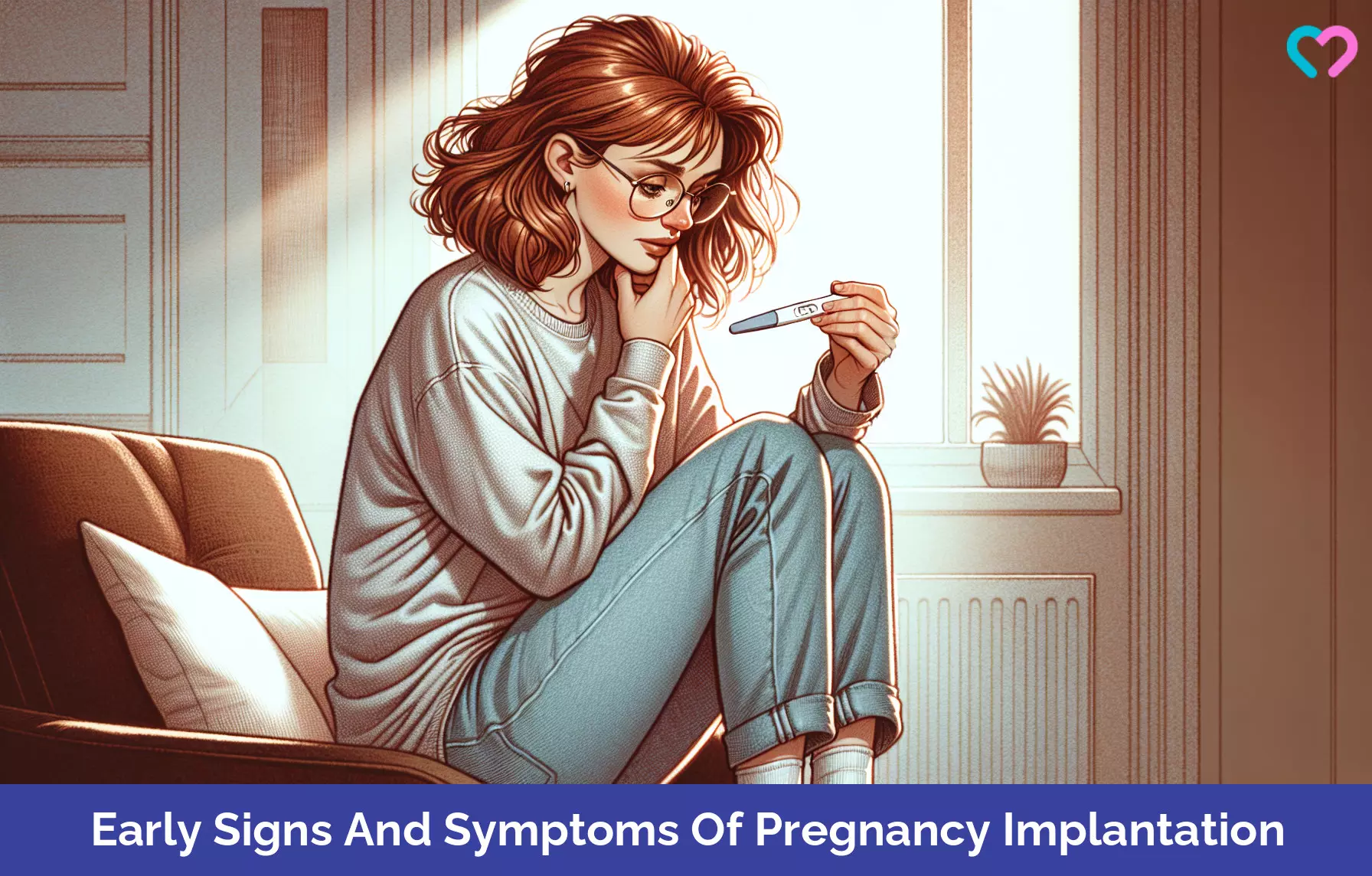
Image: Dall·E/MomJunction Design Team
Learn about the signs and symptoms of implantation and early pregnancy and find out how early you can take a pregnancy test.
Personal Experience: Source
MomJunction articles include first-hand experiences to provide you with better insights through real-life narratives. Here are the sources of personal accounts referenced in this article.
i. How do I know I am pregnant before my missed period;
https://www.youtube.com/watch?feature=shared&v=gZ3oLdCWqks
ii. Feeling Implantation?!! Pregnancy Update Weeks 0-4 | Early Signs & Symptoms;
https://www.youtube.com/watch?feature=shared&v=oc4CX2gfadE
References
- Grace S. Chung et.al; (2012); Obstetrician-gynecologists’ beliefs about when pregnancy begins.
https://www.ajog.org/article/S0002-9378(11)02223-X/fulltext - Antenatal Care Module: 5. Fertilisation, Implantation and the Fetal and Placental Circulation.
https://www.open.edu/openlearncreate/mod/oucontent/view.php?id=35&printable=1 - Bleeding During Pregnancy.
https://www.acog.org/womens-health/faqs/bleeding-during-pregnancy?utm_source=redirect&utm_medium=web&utm_campaign=otn - Chien-Chu Huang et.al; (2025); Establishment of the fetal-maternal interface: developmental events in human implantation and placentation.
https://www.frontiersin.org/journals/cell-and-developmental-biology/articles/10.3389/fcell.2025.1200330/full - Su-Mi Kim and Jong-Soo Kim; (2017); A Review of Mechanisms of Implantation.
https://www.ksdb.org/archive/view_article?pid=dr-21-4-351#:~:text=To%20achieve%20successful%20implantation%2C%20the - Jeeyeon Cha et.al; (2012); Mechanisms of implantation: strategies for successful pregnancy.
https://pmc.ncbi.nlm.nih.gov/articles/PMC6322836/#:~:text= - Alok Sharma and Pratap Kumar; (2012); Understanding implantation window, a crucial phenomenon.
https://pmc.ncbi.nlm.nih.gov/articles/PMC3409914/#ref2 - Dr. Kalyani Singh; Assessment of First Trimester Vaginal Bleeding Using Ultrasound Sonography.
https://www.alliedacademies.org/articles/assessment-of-first-trimester-vaginal-bleeding-using-ultrasound-sonography.pdf - Signs and symptoms of pregnancy.
https://www.nhs.uk/pregnancy/trying-for-a-baby/signs-and-symptoms-of-pregnancy/ - Normal Breast Development and Changes.
https://www.urmc.rochester.edu/encyclopedia/content.aspx?contenttypeid=85&contentid=P00151 - Basal Body Temperature.
https://my.clevelandclinic.org/health/articles/21065-basal-body-temperature - Pregnancy – identifying fertile days.
https://medlineplus.gov/ency/article/007015.htm - Am I Pregnant?
https://my.clevelandclinic.org/health/articles/9709-pregnancy-am-i-pregnant - Ochoa-Bernal MAl and Fazleabas AT; (2025); Physiologic Events of Embryo Implantation and Decidualization in Human and Non-Human Primates.
https://pmc.ncbi.nlm.nih.gov/articles/PMC7139778/ - Justin M. Wolter; (2013); The Process of Implantation of Embryos in Primates.
https://embryo.asu.edu/pages/process-implantation-embryos-primates - Pregnancy Test.
https://medlineplus.gov/lab-tests/pregnancy-test/ - Lisa S. Brown; Nutritional Requirements During Pregnancy.
https://samples.jbpub.com/9780763777920/77920_CH01_001_024.pdf - Eumenia Costa da Cunha Castro and Edwina Popek; (2018); Abnormalities of placenta implantation.
https://onlinelibrary.wiley.com/doi/full/10.1111/apm.12831 - Ectopic Pregnancy.
https://embryo.asu.edu/pages/ectopic-pregnancy - ydatidiform mole.
https://medlineplus.gov/ency/article/000909.htm - Bleeding in Pregnancy/Placenta Previa/Placental Abruption.
https://www.chop.edu/conditions-diseases/bleeding-pregnancyplacenta-previaplacental-abruption - 5 Things to Remember During the Two Week Wait.
https://www.lancastergeneralhealth.org/health-hub-home/motherhood/getting-pregnant/5-things-to-remember-during-the-two-week-wait - Jinxiang Wu et.al; (2025); Maternal anxiety affects embryo implantation via impairing adrenergic receptor signaling in decidual cells.
https://idp.nature.com/authorize?response_type=cookie&client_id=grover&redirect_uri=https%3A%2F%2Fwww.nature.com%2Farticles%2Fs42003-022-03694-1 - Tanya Timeva et al; (2014); Recurrent Implantation Failure: The Role of the Endometrium.
https://pmc.ncbi.nlm.nih.gov/articles/PMC4227974/#:~:text=
Community Experiences
Join the conversation and become a part of our nurturing community! Share your stories, experiences, and insights to connect with fellow parents.
Read full bio of Dr. Suman Lal
- Dr. Emily K. Osman earned her medical degree from University at Buffalo Jacobs School of Medicine and Biomedical Sciences and completed her residency in Obstetrics and Gynecology at the Medical University of South Carolina (MUSC). She did her Reproductive Endocrinology and Infertility (REI) fellowship training at Jefferson-RMA Fellowship Program in Basking Ridge, NJ.
 Dr. Emily K. Osman earned her medical degree from University at Buffalo Jacobs School of Medicine and Biomedical Sciences and completed her residency in Obstetrics and Gynecology at the Medical University of South Carolina (MUSC). She did her Reproductive Endocrinology and Infertility (REI) fellowship training at Jefferson-RMA Fellowship Program in Basking Ridge, NJ.
Dr. Emily K. Osman earned her medical degree from University at Buffalo Jacobs School of Medicine and Biomedical Sciences and completed her residency in Obstetrics and Gynecology at the Medical University of South Carolina (MUSC). She did her Reproductive Endocrinology and Infertility (REI) fellowship training at Jefferson-RMA Fellowship Program in Basking Ridge, NJ.
Read full bio of Rebecca Malachi
Read full bio of Dr. Ritika Shah
Read full bio of Reshmi Das









